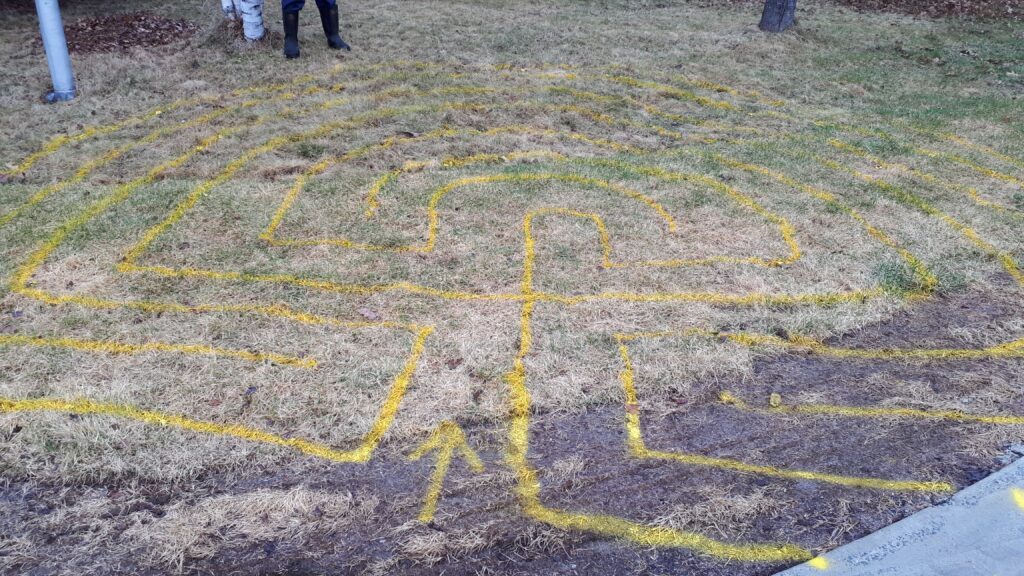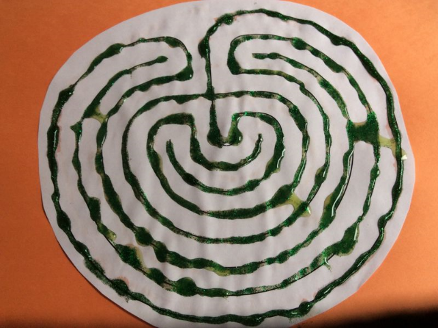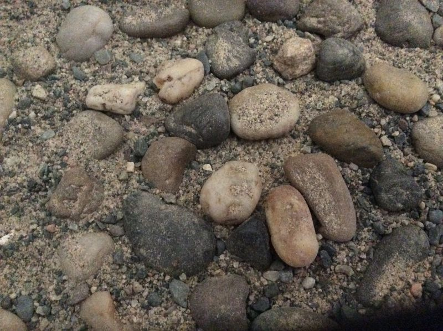Labyrinths are very ancient spiritual symbols and have appeared in some form in many cultures. They are associated with many different ideas. One of the most important is that, unlike a maze with tricks and dead ends, the labyrinth is a path that you can trust and this is sometimes seen as a symbol of God – the path we can trust.
There is no right way to walk a labyrinth. Here are just a few ideas for ways in which families can walk or build outdoor labyrinths, create finger labyrinths for use on rainy – and any other days – and use labyrinths for meditation and fun.
Building your own outdoor labyrinth is a fun and relatively straightforward activity. The following instructions are provided by Tim Lehman who built the labyrinth in the pictures in his yard to celebrate World Labyrinth Day this year (2020). It has been greatly enjoyed by the neighbourhood children. Tim’s instructions use spay paint, but you could just as easily use sidewalk chalk, rocks or rope.

Simple Lawn Labyrinth – can be adapted for the beach or the driveway
Materials
- 2 – 4 cans of spray paint (need a can with a narrow spray – Tim used Nelson Tree Marking paint from Exploration Services on Notre Dame, Sudbury)
- gloves
- spray handle if you have one
- yard stick or other measuring device to start and calibrate your eye
Space
- 15 ft X 16 ft (5 m X 5 m) for a 1 ft (30 cm) width between lines
- 24 ft X 25 ft (8 m X 8 m) for a 1.5 ft (45 cm) width between lines
Directions Follow Amy Hallman Grout’s directions for a finger labyrinth but instead of spacing the lines and dots a finger width apart space them either 1 ft or 1.5 ft apart.
It is best to layout the labyrinth in an area where the base (entrance) is straight, not on a curve.
Hold the spray can about 6 in (15 cm) to 12 in (30 cm) above the ground. Spray in a continuous jet. Spray when it is calm (no wind).
You can also use the following pattern is provided by Gailand MacQueen.

Rainy Day Fun with Labyrinths
Children usually enjoy learning to draw labyrinths for themselves, but you can also download patterns.
Or follow Instructions for how to draw a simpler three ring labyrinth.
You can draw labyrinths on all kinds of surfaces – rocks work really well – and there are all kinds of things you can do with labyrinths you have drawn or printed off. Let your imaginations go wild!




Meditations
Here are some meditations children can use as they walk the labyrinth or trace the labyrinth with their fingers.
- A basic guide: At the entrance to the labyrinth, take deep breaths and relax. Trace the labyrinth slowly with your finger or walk slowly. Concentrate on your breathing. At the center of the labyrinth, pause and think about how you are feeling. Slowly walk or trace your path out of the labyrinth. Pause at the exit and focus on how you are feeling. You might want to share your feelings when all members of the family have finished their walk.
- Gratitude: As you walk to the center of the labyrinth, think of all the things you have to be grateful for – not just material things but all the things that make you happy and joyful. At the center of the labyrinth, take a minute to thank God for all these blessings. As you walk out of the labyrinth, think of all the ways you can share your blessing with your friends, your family and your community.
- Focus on the senses: As you walk into the center, focus on the things you can hear as you walk. Pause in the center and focus on the feel of the ground under your feet. As you walk out, focus on all the things you can see. When you leave the labyrinth what things you especially noticed and how these things made you feel.
- Walking meditation: Before you begin walking, talk about all the different ways you could walk the labyrinth – as though you were on thin ice or in deep snow, like a robot, like a monster, like a soldier, like a fairy, like a superhero. Pick three ways to walk – one into the center, one in the center, one on the way out. When you’ve finished the walk, talk about how your body moved differently and how the different movements made you feel. Talk about how we use our bodies to show our feelings and how we can sometimes change the way we feel by changing the ways we use our bodies. (Adapted from Planting Seeds: Practising Mindfulness with Children by Tich Nhat Hanh).
Just Having Fun!!!
The labyrinth is often approached very seriously and sometimes this is appropriate, but sometimes it’s good just to have fun. Here are some ideas:
- Make rain sticks or shakers and walk the labyrinth listening to the sounds they make.
- Blow bubbles as you walk the labyrinth. Watch the colours and the patterns and think about how they move and burst.
- Dance through the labyrinth to show how you are feeling.
- Make different rhythms on a drum or other percussion instruments and move to the beat of your music.
If you are using a public labyrinth when others are present, please remember that they may need quiet to enjoy their labyrinth experience.
Other resources
